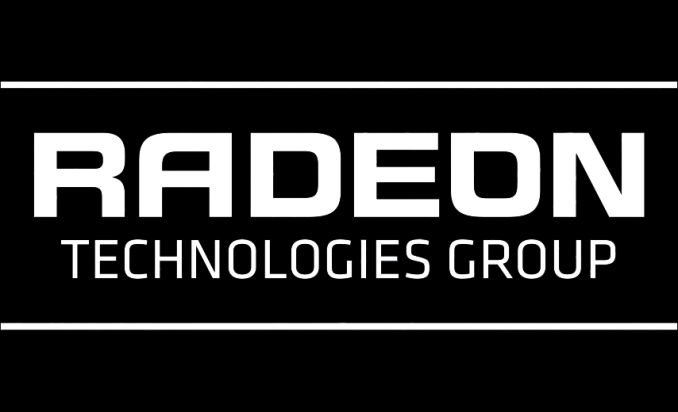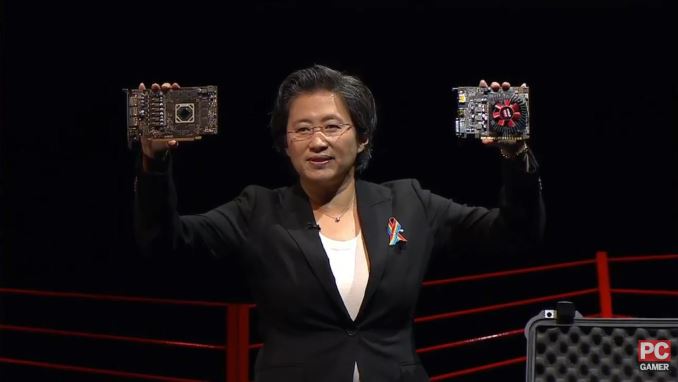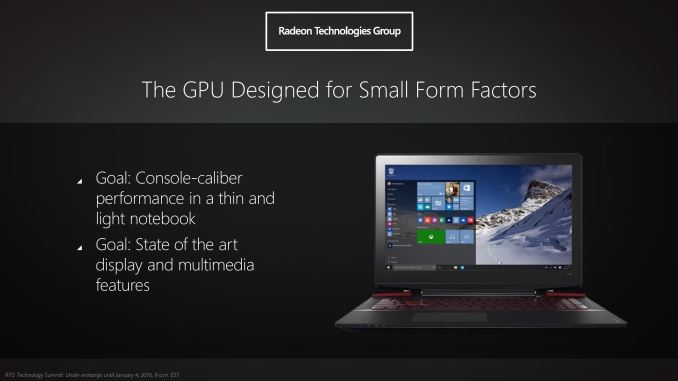AMD Teases Future Radeon RX 470 & Radeon RX 460 Cards
by Ryan Smith on June 13, 2016 3:30 PM EST
With the annual Electronic Entertainment Expo once again upon us, this week has been a flood of gaming hardware and software news. On the PC front, AMD is once again sponsoring PC Gamer’s PC Gaming Show, and while the company isn’t making quite as large of a presence this year – having just announced a bunch of tech at Computex – AMD is still attending E3 to tease a bit of hardware. Announced in a press release that’s going out at the same time as the PC Gaming Show starts, AMD is very briefly teasing the next two Polaris-based Radeon cards: the Radeon RX 470 and the Radeon RX 460.
AMD previously teased the Radeon RX 480 back at Computex, and with that card not shipping until the end of this month, the RX 470 and RX 460 are even more brief teases, essentially amounting to AMD confirming that they will exist.
As you can assume from the numbers, the RX 470 and RX 460 will slot in below the $199 RX 480. AMD’s press release specifically notes that the RX 470 is a “refined, power-efficient HD gaming” card. Whereas the RX 460 is a “a cool and efficient solution for the ultimate e-sports gaming experience.” These are no further details such as performance, specifications, or pricing, so this is a true teaser in every sense of the word.
Based on their admittedly short descriptions, it sounds like the RX 470 and RX 460 will slot in to very similar positions as the R7 370 and R7 360 respectively, as these are the same markets AMD pitched those cards at. This would make the RX 470 a budget 1080p card, while RX 460 is pitched specifically at MOBA players and the like, as those games have relatively low system requirements. Lower-end cards of this nature have also proven very popular in China, where MOBAs are especially popular and the pricing is better aligned with what most consumers can afford.
For what it’s worth, those cards launched at $149 and $109 respectively, so that may give us a ballpark idea of what to expect. Note that AMD only has two Polaris chips – the larger Polaris 10 and the smaller Polaris 11 – so it’s not clear how AMD may split these up. Historically, Radeon x60 cards have been based on chips that have been prevalent in smaller, mid-performance laptops.
On that note there’s one last passage from AMD’s press release I want to point out. In reiterating their talking point about bringing “console-like” performance to thin and light laptops, AMD’s release mentions that Polaris offers “exceptionally low power and low-z height.” Like everything else, no further details are provided, but I don’t suspect this is the last we’ve heard of this point. Having seen a very early Polaris 11 last December it’s definitely a small chip, and it sounds like AMD focused not just on package size, but thickness as well. Z-height is not something I’ve previously paid attention to, so I’m not immediately sure how thick AMD’s last-generation chips were, or whether this has been much of a problem on a competitive basis.












105 Comments
View All Comments
nunya112 - Monday, June 13, 2016 - link
and If AMD followed their own advice once in a while. they better release a 480X off the bat. Last time we waited what 8 months till they even released a 4gb VANILLA 380. and then we waited EVEN LONGER for the 380XThe_Countess - Wednesday, June 22, 2016 - link
there will be no X versions this time round.ddriver - Monday, June 13, 2016 - link
"ANd I love AMD" - 2 brain cells worth of nvidiot troll disguisenunya112 - Tuesday, June 14, 2016 - link
mate my current video card is a R9 380 4GB with a i5 6500 16gb 2400 ramyour Mom even comes and cleans it in a nice little maids uniform and everything. he also cleans my 40" hint it's not my TV.
ddriver - Tuesday, June 14, 2016 - link
No need to keep exposing yourself as a mindless troll, it is already beyond obvious.Alexvrb - Tuesday, June 14, 2016 - link
Uh, Nvidia purchases are mostly in the mid-range, too. The high-end is a valuable market too but the bulk of GPUs sold are under $300. If you can't design and release 3 GPUs at once, then going after the low-end, the mid-range, and mobile is not a bad plan.That last part is something a lot of people overlook. Polaris 11 AND 10 can both scale down into lower TDPs for use in multiple laptop segments.
nunya112 - Tuesday, June 14, 2016 - link
yeah but under a 380 or 480 the video cards become a useless exercise. onboard usually usually prefered than a 360/370 thats just a waste of cash buying a 360/70Nigellus - Tuesday, June 14, 2016 - link
But last leak shows the 480 doing 3 315 score on fire strike ultra. A fury air for 200 bucks?Ashcutus - Tuesday, June 14, 2016 - link
Of course everyone wants a high end card! I want a mansion, my own tropical island and a fleet of supercars!It all comes down to what the highest selling market is, and clearly that is the $200-$300 range of cards (your 390's and 960/970's) so by releasing a card that is more powerful than any existing cards in that range (probably by a fair bit in some instances), using far less power and heat makes plenty of business sense to me.
fanofanand - Tuesday, June 14, 2016 - link
The highest selling market is more likely in the $100-$150 range. People forget that the Asian market is enormous and they buy a ton of low/mid GPU's. For every 1080 Sold in America there are 100 950's sold in Asia. (yes I just pulled those numbers out of my azz but last info I read said something similar).